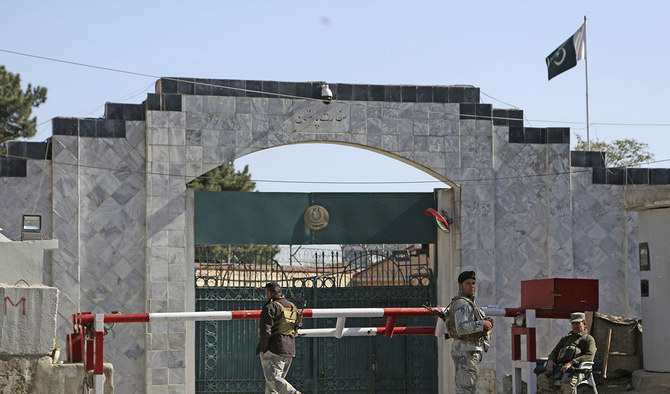Afghanistan’s capital city has once again plagued by violence with gunfire erupting at the Pakistani embassy to target Pakistan’s chief envoy and a suicide bombing attack to target a famous Afghan politician.
A gunman opened fire from a nearby building near the embassy as Pakistan’s Chargé d’Affaires to Afghanistan Ubaidur Rehman Nizamani, was leaving. Nizamani was unscathed but his guard was critically wounded and evacuated to Pakistan for treatment.
The Islamic State (IS) , also known as the Daesh group, took credit for the attack, claiming two of its members armed with “medium and sniper weapons” targeted the ambassador and his security personnel.
On the same day, two suicide bombers attacked Iman Mosque of Hizb-e-Islami office of Gulbuddin Hekmatyar, in which two guards and two assailants were killed. Some source suggests that the assailants intended to detonate a car bomb, but were interrupted by Hekmatyar’s bodyguards. One of the suicide bombers was wearing a woman’s burka at the time of attack. Gulbuddin Hekmatyar survived the assassination attempt, but lost two of his guards.
While no group is ready to accept responsibility for the attack on Hekmatyar, but the nature and timing indicates that Daesh could be behind that too.
Pakistan asks Afghanistan to beef up security at Kabul embassy
Pakistan’s Special Representative for Afghanistan Muhammad Sadiq asked the Afghan government to “beef up the security of our embassy and its personnel”.
“Our top most priority is the security of members of our mission,” Sadiq said, adding that security guard of Nizamani, Sepoy Israr Mohammad, “who took bullets on chest” was evacuated to Combined Military Hospital in Peshawar by a special plane. No updates were given on his health condition, but officials confirmed he is in ICU.
While saluting the extraordinary courage and devotion to duty of the guard, Sadiq called on the Taliban to beef up the security of Pakistan’s embassy and its personnel.
Pakistan Prime Minister Shehbaz Sharif condemned the “assassination attempt” on the top, demanded immediate investigation and action against perpetrators of this heinous act.
Nizammani landed in Kabul last month to take up his position at one of a few embassies that has continued to function in Afghanistan following seizure of power by Afghanistan last year.
Taliban vows action
Afghan Foreign Minister Amir Khan Muttaqi spoke with his Pakistani counterpart Bilawal Bhutto Zardri on phone condemned the attack on the embassy and assured to bring the perpetrators to justice swiftly. He also reiterated Afghanistan’s firm resolve to combat terrorism.
Bilawal said that the Afghan government must prevent the terrorists from undermining relations between Pakistan and Afghanistan. He also reiterated Pakistan’s unwavering commitment to fight terrorism and said that Pakistan will be undeterred by such cowardly attacks.
Zardari also affirmed that his country has no plan to close its embassy or withdraw its diplomats from Kabul.
Although Pakistan does not officially recognize Afghanistan’s Taliban government, but has kept its embassy open and maintains a full diplomatic mission.
Meanwhile, the Afghan security forces arrested a suspect involved in the assassination attempt on Nizamani. Sources say that he was residing on the 8th floor of the nearby building, and the suspect tried to escape, however he was arrested by the Afghan forces. An AK-47 rifle, a long-range automatic rifle, a sniper rifle and other weapons were also discovered from the possession of the suspect.
Mutually useful cooperation remains missing
Now when it is clear that Daesh has taken the responsibility for the attack on the Pakistan embassy, it has unfolded in some dimensions. For a start, it shows that there is still a security failure and gap beside the Taliban maintained security at this point. Another factor could be that some Taliban fighters who think the Taliban as sellouts have joined the Daesh on the sly. This also raises alarm bells for Pakistan, and there is possibility of more attacks against Pakistanis and even the Daesh group could spread its activities inside Pakistan. And In the most pessimistic view, what will happen to Pakistan if Daesh and Tehrik Taliban Pakistan (TTP) will pledge loyalty to each other.
TTP is basically a Pakistani issue, but the Taliban should not underestimate Daesh as it already claimed responsibility for several deadly attacks across Afghanistan since Taliban returned to power in August 2021. If TTP and Daesh become friends, no matter Afghanistan or Pakistan, they only need to follow their agenda, and friends morally help each other.
We should not forget that TTP and Taliban already have great ties and the Taliban were also acting as an honest broker between the TTP and Pakistan. However, the mediation efforts have come to naught, and the TTP is once again on the rampage as it just recently carried a car bombing in Pakistan. TTP also called off a ceasefire with Pakistan and ordered its fighters to carry attacks across the country.
The enemy of my enemy is my friend
There is a great saying that “the enemy of my enemy is my friend”. Taliban are friends to Pakistan and also Taliban are friends to TTP, but TTP is the enemy of Pakistan. TTP had already declared war with Islamabad, and Daesh is now on the same path. At the same time, Daesh is the enemy of Taliban. In this contest, TTP-Daesh is the main point of concern for the peace and safety of Afghanistan and Pakistan as well as the region. It wouldn’t be naïve to think that TTP will not join Daesh to wage more war against Pakistan in the wake of attack on the Pakistan embassy in Kabul. Unluckily, if TTP and Daesh established ties, confronting them will not be painless. Daesh already sent an alliance message to TTP by attacking a Pakistan compound.
At this stage, it is essential that Kabul and Islamabad should stop complaining or to engage in some sort of blame game that seems to be developing, and instead take concert measures that will bring matters under control. This is not really carrying weight to see that both sides agreed that embassy-like attack will not harm the mutual ties between the two countries, but what is important is to think carefully how to deal with Daesh and TTP as they are growing rapidly and splitting out of control.

 OPINION2 weeks ago
OPINION2 weeks ago
 DIPLOMACY2 weeks ago
DIPLOMACY2 weeks ago
 DIPLOMACY7 days ago
DIPLOMACY7 days ago
 ASIA2 weeks ago
ASIA2 weeks ago
 DIPLOMACY1 week ago
DIPLOMACY1 week ago
 MIDDLE EAST2 weeks ago
MIDDLE EAST2 weeks ago
 ASIA1 week ago
ASIA1 week ago
 MIDDLE EAST1 week ago
MIDDLE EAST1 week ago


















